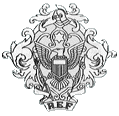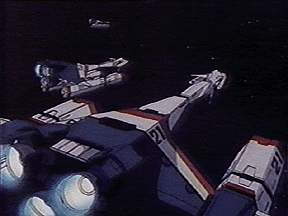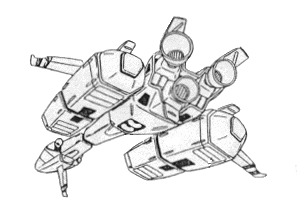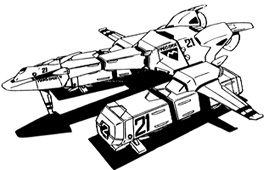

Designation:Horizont Class Transatmospheric Assault Transport |

|
||||

|
|||||
The Horizont shuttles were not formally given names. Continuing the tradition set by the Predator Assault Shuttles, the crews often gave their shuttles names by using those of those of carnivorous or otherwise imposing animals, and in time, these names were used in message traffic and became semi-official.
A total of 657 Horizonts were built by the REF between 2034 and 2044.


The Horizont Troopship served the REF in the capacity of an all-weather, highly maneuverable delivery system for troops and supplies from space onto a planet surface. Though, due to their anti-gravity systems and strong hulls, all REF vessels were capable of planetary landings, assuming the landing area was relatively flat, none of these ships were particularly maneuverable in an atmosphere. Only the Predator Assault Transport and the Horizont could deliver men and supplies into a fire fight and have a reasonable chance of leaving quickly.
The Horizont is rather like a very large aircraft, relying on aerodynamics and its large thrust to mass ratio for its atmospheric operations. In space, small vectorable nozzles take the place of the control surfaces on the wings. Furthermore, for atmospheric hovering operations, limited anti-gravity units can be activated for vertical take-off and landings, or to drop the cargo pods from a low altitude without landing.
Under either wing of the Horizont an enormous bunker, capable of carrying men, mecha, cargo, or a specialized C3I (Command-Control-Communications-Intelligence) bunker with all hands, can be mounted. If the Horizont is configured as a tanker, specialized pods will carry reaction mass for the fighters, missiles to replenish them and oxygen for the life support systems and, for Shadow fighters, liquid nitrogen cooling fluid. The Alpha-Beta fighter combination is stored on the underbelly of the Horizont, between the two bunkers.
The interior of the Horizont is small, and the crew-accessible spaces are as follows, from bow to stern. Foremost is the command cabin, where the vehicle is piloted and where the tactical and communications specialists are stationed. Aftwards of this cabin is a small lounge, with limited food stores and a small head, so crew members can rest their legs and eat. The lounge also contains two stored bunks. The cabin and lounge form an escape capsule, and can be separated from the rest of the ship by two dedicated one shot rocket engines. In space, the pod would drift until another ship came by to pick it up, in an atmosphere the pod would set down by means of a parasail. The cabin can operate with all hands for 12 hours before life-support runs out.
Aft of the command module is a hall space where fourteen REF Cyclone infantrymen can await their insertion into a landing zone. The soldiers lie in recesses in the walls, with their Cyclones, in box-storage mode, stowed above them in overhead compartments. A hatch from this area leads aftwards to a downwards gangway and ladder, emerging at another hatch that opens into the Alpha access bay. From here, the technician can refuel the Alpha's fusion engines, the reaction-mass tanks, or the protoculture supply, as well as the life support tanks. The bay can be raised and lowered, and in the lowered position, fits snugly over the Alpha nose and cockpit. When the Alpha is launched, the bay is raised, the gap in the floor is sealed by a sliding shutter-door, and the Alpha/Beta combination is released from the Horizont. On a planet surface, the bay can be lowered, and serves as the staging area and egress point for the Cyclone riders. Inside a larger vessel or a REF base, the bay is mated to a ramp, and the crew embarks and disembarks from this point.
Since it is impossible to board a Beta fighter when it is mated to an Alpha (and even if it were, there would be no room for a Beta access bay on the Horizont design), the Beta is generally unmanned; the only exception is when the fighter pair has recently arrived from another ship; and all the Beta pilot can do is remain in his cockpit while docked. Because there is no external access to either plane, except to the Alpha's nose and cockpit area, neither fighter can be rearmed while docked with a Horizont, unless one of the cargo pod hardpoints is taken by the specialized In-Flight Service (IFS) pods.
Because of the cramped conditions, Horizonts were not intended to be fully crewed for long periods; if it was necessary to have more Horizonts than could be stored in the hangar bays of ships-of-the-line in the Horizonts' battle group, standard operating procedure would be for all Horizonts to remain outside the vessels, without troop complement or bunkers, operated by a skeleton crew of two that would rotate every twenty four hours by docking with the mothership. Attachment of the bunkers and loading of full crew and armored infantry would occur in the hours prior to battle.
Other than the Alpha/Beta fighter combination, the Horizont is weaponless, a liability that caused the loss of many of these vessels over Earth in the attempt to liberate the homeworld from the Invid occupation. To remedy this, the RNF decided after the Third Robotech War to introduce a troopship design similar to that used by the Robotech Masters in conjunction with a more heavily armored and newly armed Horizont refit.
The Horizont design was drawn up after the taking of Tirol, with its specifications based on the experience of years of aerospace operations while searching for the homeworld of the Robotech Masters, and on the experience gained while taking Tirol from the Invid. These campaigns had been waged with the Predator Assault Transport and several refitted Kitsune class logistical support vessels. However, the REF had both suffered losses among these ships and ascertained that the Predator, while armed and fast, lacked the bulk cargo space required and the Kitsune vessels, based on the Frandlar Tiluvo Zentraedi cargo pods, were nearing the end of their operational lives, and required ever more maintenance. Hence, the REF Naval Command drew up specifications for a new dropship design that would replace both types.
The resulting design was based on a new cargo-delivering methodology. Rather than having the dropship fight its way through to the surface, like the Predator was designed to do, the new Horizont would be escorted down by heavy fighter cover. The deletion of the armament, as well as advances in engine design and anti-gravity pods, gave the Horizont almost 500% more cargo capacity over the Predator at almost no additional mass. The cargo was no longer carried internally, but in two ejectable cargo pods. This system made it more flexible to set up temporary bases and repair facilities, thus replacing the Kitsune class as logistic centers.
As the Horizont could accelerate to orbit again and pick up a new load when the older designs would be either grounded ( Kitsune) or unloading (Predator), the cargo throughput of the new shuttle system was increased overall. Furthermore, keeping in mind the spaceborne nature of most REF operations, extra safety for the crew was provided for by using a space-capable escape pod. The Horizont was thus produced at Tirol beginning in mid-2034.
The Horizont could be configured as a tanker and rearming vessel by mounting specialized pods containing reaction mass, five Alpha docking ports and two docking bays. Alphas with low fuel levels could refuel on those ports, other mecha and Alphas in need of missile replenishment would have to use the fore or aft docking bay.
Although the Horizont did meet every specification, it was not liked very much by the people assigned to fly it. The long, thin neck and slender wings conveyed too much of a sense of vulnerability too ease the minds of its crew. In addition to the defense being sacrificed for cargo capacity, the Horizont was not particularly comfortable, yet had to be manned almost constantly during battle deployments because of the limited docking space available. This procedure, described above, remained standard until after the wars, when new dropships were made compatible with conformal docking slots in the RNF and Tirolian Navy's larger ships.
The Horizonts' crews' apprehension about their crafts' vulnerabilities was proven correct in the Invid campaigns, when it became clear that the Horizont could not withdraw in time if it was engaged in loading or unloading, and that the design was particularly vulnerable during re-entry. Because of this, the main use for the Horizonts in an attack role was the dropping of a large number of cargo boxes in a relatively undefended spot, and even that only under heavy fighter and warship escort. Even this could prove fatal if the enemy capabilities were misjudged, as evidenced by the disasters in Earth-space that befell this class. In those attacks, most Horizonts that survived the Invid burned up on re-entry in the atmosphere because they had let their speed reach too high a level (trying to escape) to safely enter the atmosphere.
Well over 650 of these vessels were produced, and though a large number of them were lost in the Galaxy-wide mop-up of the Regent's Invid, most were lost over Earth in the Hercules, Mars and Jupiter division descents. Only two in five of those in the Jupiter and Minerva Groups, and of course the full Tirolian contingent, survived, although a few crashed reasonably intact to Earth. Though the crews were usually killed, the bunkers became gold mines for scavengers, and many of the mecha these bunkers carried fell into the hands of resistance fighters in the struggle against the Invid.
As the REF, on arrival on Tirol, had come into possession of some abandoned Robotech Master Roil assault corvettes, with their compact design, heavy armor and powerful weaponry coupled to a large transport capacity, the general opinion of the Horizont crews (and many other REF personnel) of the new shuttles was and remained very low. Indeed, there were numerous suggestions to use refitted Roil corvettes or copies of this design. However, while a program to this purpose was begun, the technology involved was so complex that it was not until 2043 before the first prototypes made their test flights, too late to be used in the final REF assaults on Earth.
After the war, these new craft took over much of the Horizonts' role. However, because the troopships could not drop cargo pods as the Horizonts could, an improved Horizont variant was procured for when C3I pods were needed or when a temporary base had to be set up. This special operations version of the Horizont featured additional armor protection and several particle gun turrets and missile launchers for self-defense.
Return to REF Naval Auxiliary index.
Go to Robotech Reference Guide Home Page.
Robotech (R) is the property of Harmony Gold. This document is in no way intended to infringe upon their rights.
Content by Pieter Thomassen, with Peter Walker and Rob Morgenstern